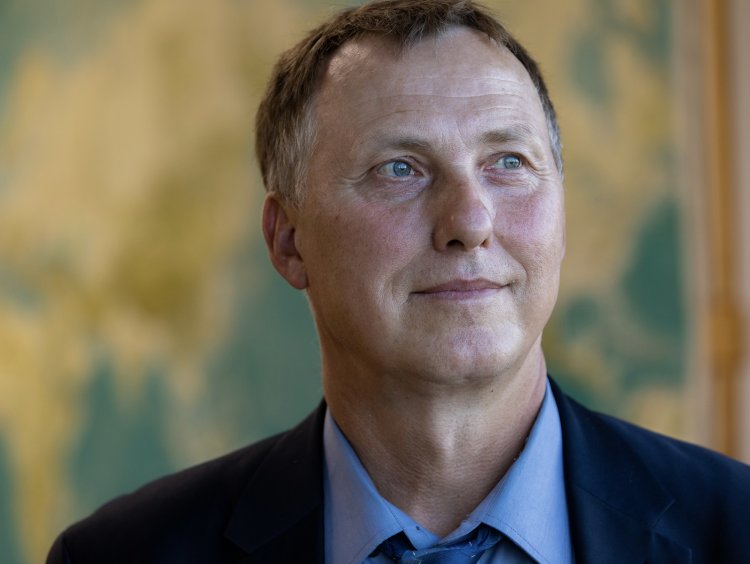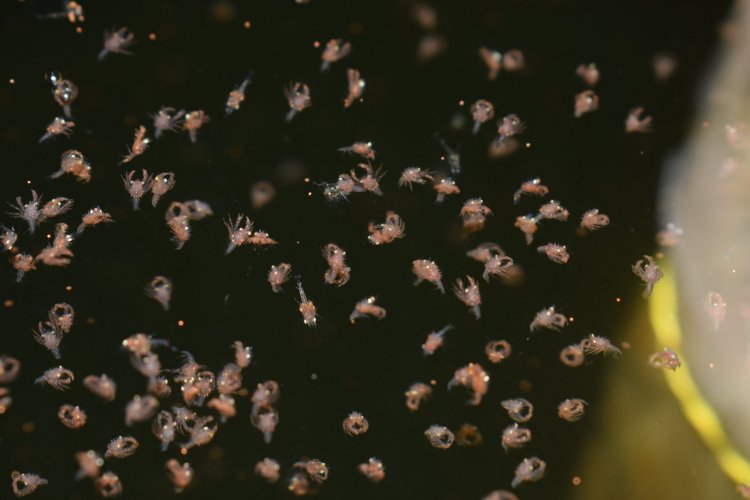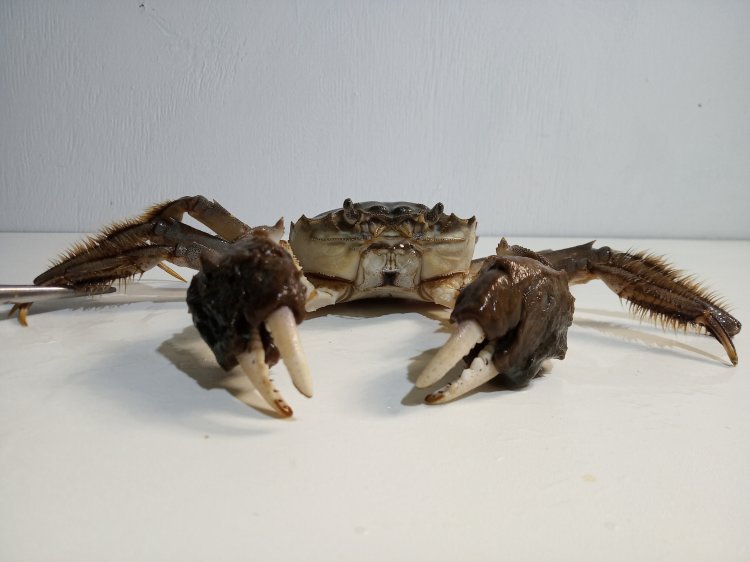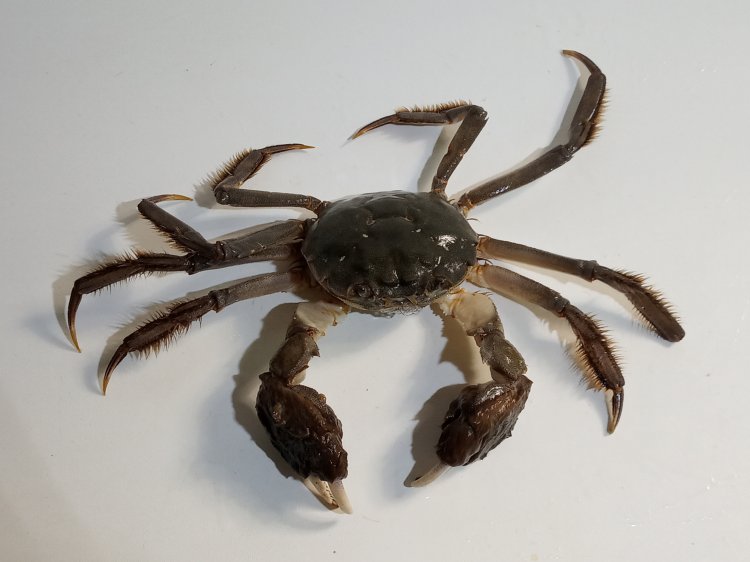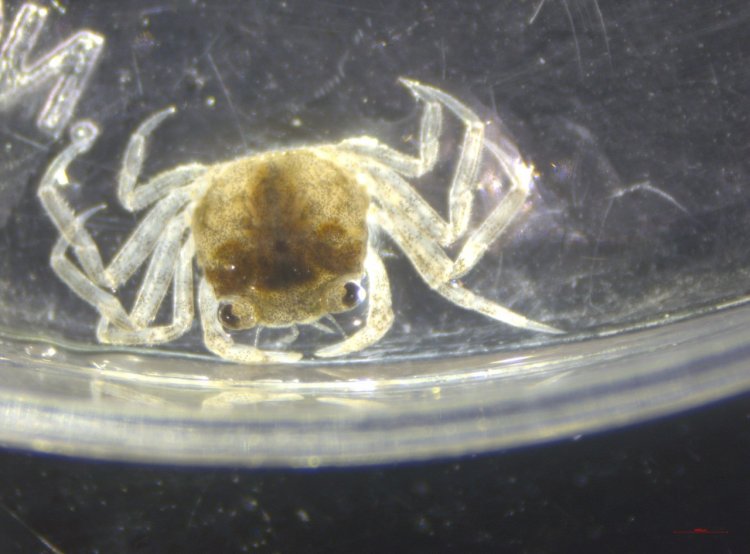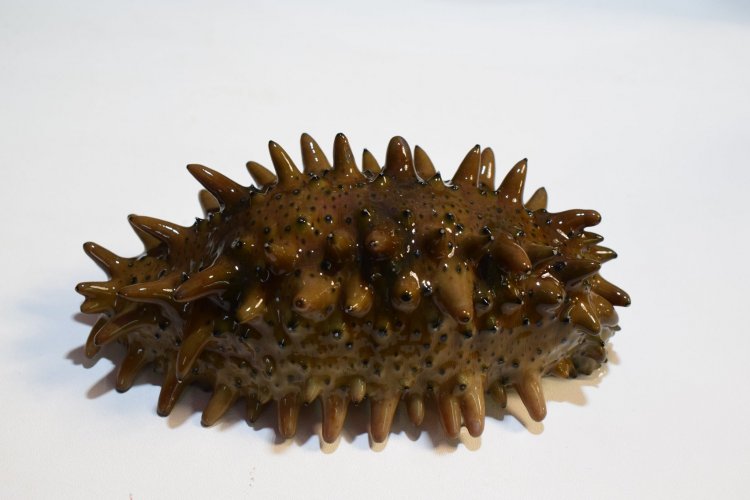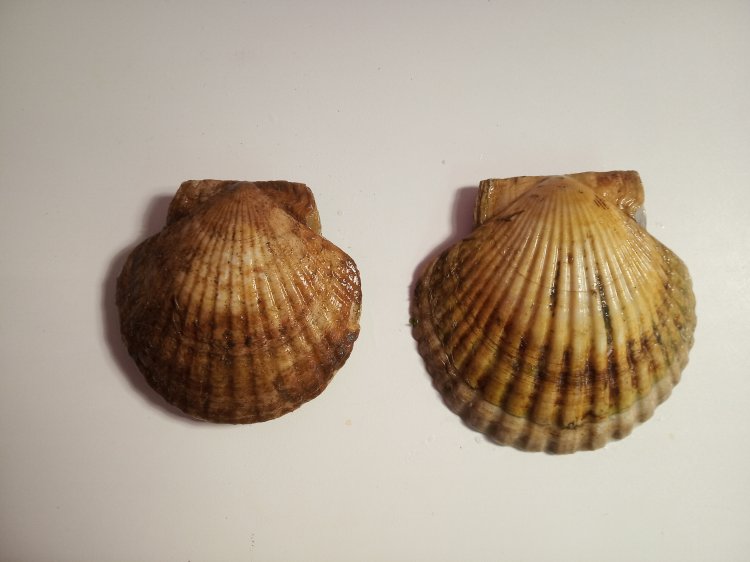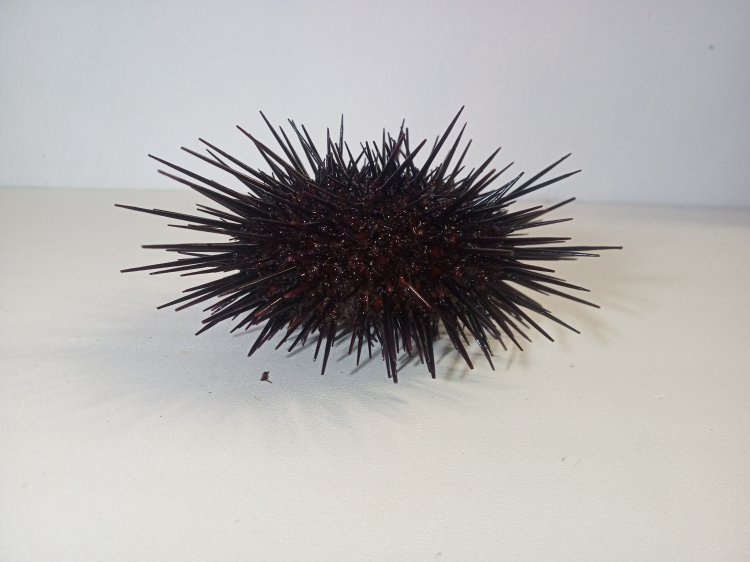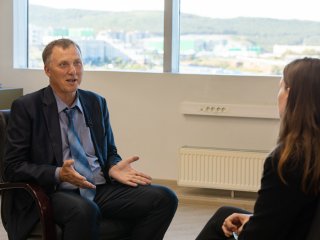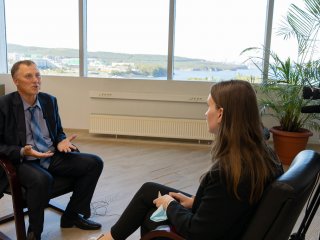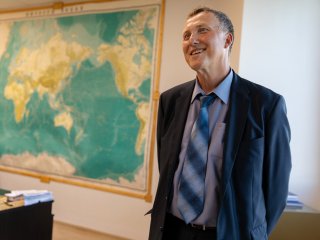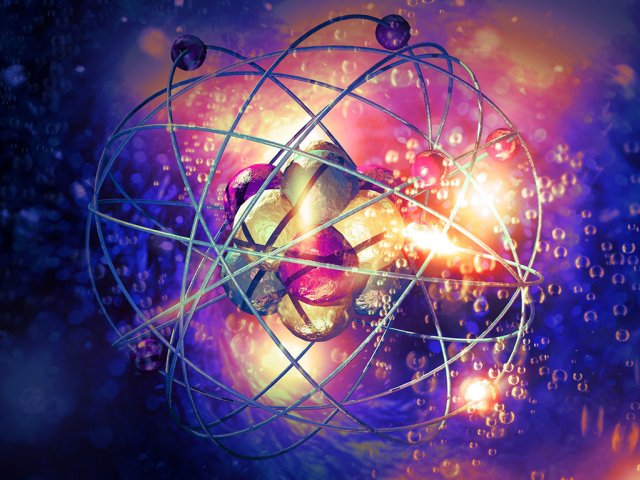The Russian Far East is washed by the most productive ocean – the Pacific. And it is here that superfood organisms live: the Red king crab, which is depicted on the cockade of the Russian civil fleet, the mysterious and nutritious trepang, or sea cucumber, the scallop, whose shell is depicted in Sandro Botticelli’s “The Birth of Venus,” the sea urchin that gives strength. At the same time, most seafood is bought from Russia by Asian neighboring countries – China, Japan, and others. Sergey Maslennikov, the head of the Center for Aquaculture and Coastal Resources, notes that a state policy in this direction is needed so that the products that the Far East is so rich in become available to Russians.
Sergey Ivanovich Maslennikov is Associate Professor, Candidate of Biological Sciences, Head of the Center for Aquaculture and Coastal Bioresources, Senior Researcher at the A.V. Zhirmunsky National Scientific Center for Marine Biology of the Far Eastern Branch of the Russian Academy of Sciences.
− First of all, let’s talk about your projects related to the production of Red king crab. Although it would be more appropriate to talk about reproduction. As we know, the Red king crab is considered an endangered species.
− Let me remind you that Red king crab has always been one of the food brands of Russia. It was discovered in Kamchatka and described in the middle of the 19th century. Red king crab is one of the largest edible crabs. And I must say - quite a tasty one.
As you know, it was the Red king crab that brought Russia a lot of foreign exchange earnings. But due to the difficulties with sustainable stock management, in the 1930s specialists tried to relocate the crab to the Barents Sea. And only in the late 60s – early 70s did they finally succeed.
It’s all about the value of this species. For example, the Red king crab is depicted on the coat of the Russian civil fleet. The Red king crab is depicted on all the sailors’ cockades. You can call it to some extent a heraldic organism.
But unfortunately, scientific data is not accumulated in one day. Therefore, due to the high value of the product and the small amount of scientific research, Russia faced a serious problem – a drop in crab catches. The crab itself grows for a very long time. It becomes commercial and sexually mature in the eighth or tenth year of life. Therefore, there should be enough crab left in the wild population for it to reproduce successfully.
Today it is very difficult to achieve sustainable natural reproduction. In any case, the total catches in the Far Eastern seas have significantly dropped. And there was a time when the total fishing stock exceeded 50 thousand tons per year. Today, this historical level is no longer achievable. Stocks have fallen by an order of magnitude, and even the Barents Sea does not save us.
Of course, we can give up on this species altogether, but it does not work, because it is very valuable, in-demand, and expensive. That is why programs for the management of the Red king crab population have been developed for many years. The first thing that comes to mind is artificial reproduction. On the one hand, the process was understandable but insufficiently studied.
We obtained the first results (and at the same time our American colleagues in the Alaska region obtained them) at the end of the 1980s. I described the first crab reproduction project in my dissertation in 1996. One of my teachers, Valery Semyonovich Levin, the author of the book Red king crab, used my classification described in the dissertation.
2 years old red king crab female. Source: Marine Biotechnopark Ltd.
Then we continued our work and tried to implement a new project already on Sakhalin in 2001. And at the end of the 2000s, together with the Russian Research Institute of Fisheries and Oceanography, we came to use the so-called factory method, when the crab fry is grown in artificial conditions. And then in 2014, together with FEFU, we participated in the RSF megagrant, within the framework of which we continued research on the creation of modern methods of artificial crab reproduction. The specialists of the Center actively used electron microscopy methods, genetic methods and accumulated a lot of experience. The study of reproduction processes in artificial conditions was resumed.
− What are the specifics of the factory method proposed by you and your colleagues?
− We built a special module, literally a mini-factory, where we managed the processes. Essentially, experiments have begun anew. I note that these experiments are quite lengthy. The crab breeds in February-March, and if we want to fix something, we can do it only after a year.
This work is similar to the work of our colleagues in agriculture, where new varieties are not bred in one year. It took us several thousand years to learn how to grow wheat or rice. At the same time, miracles are expected from scientists and the Academy of Sciences, and they also complain that we are moving slowly. We move slowly because our capabilities are limited by nature itself.
But I think this is for the best. During the research, we have accumulated quite a lot of information. This made it possible to launch the site based on the existing mini-plant. Four years ago, a scientific experimental section of mariculture was formed at the Institute. And we have received engineering and scientific support. Now the Center employs mainly young scientists, as well as graduate students. As soon as this energy of the young appeared, the project began to bring results.
Red king crab larva
By the way, in 2021 we got a very good result thanks to the skills and developments accumulated over more than ten years. We managed to get a fairly good experimental herd of crabs. When we published the interim results, many large companies and partners became actively interested in the Center’s research. So, one of the leaders of the largest company in Russia found out that we are going to release the crab into the environment. He quickly arrived to see so many crab fry with his own eyes for the first time. A kind of kindergarten. I have repeatedly noticed that people who see a lot of juveniles for the first time, whether it’s a scallop or a crab fry, are sincerely happy.
Now we are working within the framework of a Russian Science Foundation grant aimed at studying edible and forage organisms in mariculture. In addition, we managed to form a partnership with a large Russian crab producer. A roadmap for the Red king crab reproduction project has also been created, with plans for industrial reproduction within a few years.
− Why is it so important?
− Obviously, we will not be able to grow a crab to a marketable size. I remind you that for this you need to wait for 8 to 10 years. Now we need to learn quite inexpensively and very consciously, that is, in a planned manner, to reproduce several tens of millions of fry units every year and release them into the environment. Therefore, the main task of the project is to find out how the grown crab will survive in the natural environment. Thus, it will be possible to calculate the required amount of crab produced to replenish the natural herd.
I’ll make a reservation right away – no special methods are used to replenish the natural herd. Mainly, developments on its nursing are used. That is, a fertilized eggs female is taken from the natural environment. In a certain season, the eggs bursts, and larvae come out. In fact, this is a completely natural process, we do not interfere with it in any way. We just need to feed this larva. In nature, about 1% of all larvae survive, and sometimes even less – 0.1 or even 0.01%.
− Why is it so?
− The crab larva is quite large, so it becomes prey for fish. Plus, it is sensitive to temperature changes. With just a small storm, the larva will be thrown into other layers of water, where it simply dies. This is one of the reasons why natural reproduction is inefficient.
In one of the theoretical articles, Valery Semyonovich Levin and I showed that since the discovery of the Red king crab, the natural environment has changed very much, namely, the state of the coastal water area has deteriorated. The shores of the seas were populated by people who began to intensively fish, dump waste.
Therefore, it is necessary to increase the survival rate of the larva, and this is not an easy task, given that the crab molts many times in the first year of life. And every molt for a crab is terrible stress. At the same time, the crab molts 5 times at the larval stage, and then 10 more times during the first year. Therefore, it must have a very large vitality to experience all these stresses. This is the secret we must reveal − the secret of vitality for the crab. In our case, what to feed it, how to keep it so that it is strong and hardy.
− You mentioned that you release the crab into the coastal zone. Is it fenced in somehow? How do you understand that these are your fry?
− Actually, this is an invented problem. After all, we are engaged in reproduction, not cultivation. Similarly, sturgeons are released into the river within the framework of the relevant state policy. And if this is not done, then there would be no sturgeon in Russia. For example, six or five countries participate in fishing in the Caspian Sea. But only Russia produces sturgeon. It’s the same with salmon plants. But no one considers them their own or strangers. It’s just that otherwise the wild population will not be able to reproduce at the pace that a person needs − the main consumer of all these valuable species.
1-year-old red king fry (juvenile). Source: Marine Biotechnopark Ltd.
Often the population decline precisely because the young cannot survive. Therefore, we are creating a kind of “kindergarten” where we grow fry. Nevertheless, as part of the work under the grant, we are still focused on finding markers that will allow us to evaluate reproduction.
Released crabs cannot be restricted. They have to crawl to the right depth, from warmer waters to colder ones. Plus, crabs have a lot of food in the sea. And if we restrict the crab’s movements, then competition will begin for a place, for food between the crabs themselves, which is what happens in our factory baths. To reduce this competition, it is necessary to increase the area. So, the open sea for a crab is an endless area.
− So, it basically mixes with its natural counterparts?
− It is part of the natural environment itself, and we just help it survive. We take the female already with eggs. And then, after the eggs burst, we return it to the sea. That is, they are completely natural crabs. Moreover, we release them into the environment, where the laws of natural selection apply to them as well as to others.
− Then let’s move on to another kind of crab, the Chinese mitten one. What cultivation technologies do you use?
− Actually, the Red king crab, although a fairly ancient animal, is not evolutionarily considered a real crab. In fact, it is a craboid – a transitional form.
And a real crab is our next subject, the Chinese mitten crab. How is it different? We joke that the Chinese mitten crab is choleric, and the Red king crab is phlegmatic. The Red king crab is very calm, it does not make sudden movements in the literal sense of the word. And its hairy relative is not like that at all.
Last year we were preparing it for transplanting into the lake and put it into boxes. It’s good that the engineer who leads them, our graduate student, came in late in the evening. Crabs, literally like monkeys, climbed out through a hose that supplies air. They got out of the water and ran around the shop. And we collected them. And by the way, not all of them were caught. The crabs are small, lively, and some managed to get into the cracks. Now we know for sure that they should never be provided with a surface on which they could get out of the aquarium or out of the bath. Such a choleric!
Red king crab is easy to put in a net, and it will sit there, phlegmatically waiting for what will happen next. The Chinese mitten crab will not wait, it will start gnawing the net and simply escape.
Japanese mitten crab. Photo provided by S.I. Maslennikov
Why is it interesting? First, the Chinese mitten crab is the most consumed in the world. In total, a million tons are eaten annually in the world. That’s because the Chinese mitten crab is one of the fastest-growing. In just two years, it grows to a marketable size about the size of a palm.
Now we are working with a more northern species – the Japanese mitten crab. This story began twenty years ago. Around 2001, I received a call and was asked to come to one of the mariculture farms in the Nakhodka area, in the Vostok Bay (where we now work). The colleagues asked for help in growing crab. But then we didn’t have enough experience. And all scientific articles were published in Japan, China, and Korea in national languages, not in English. It was only at the end of the 2010s, during the rapid development of the Internet and the transition of Asian science to an international standard, that the necessary information appeared. So about three years ago, we managed to get young Japanese mitten crab and put it in the lake, where it grows up.
Why is it interesting for us? Since we are working with a northern species, we managed to find out that the crab in Primorsky Krai grows in freshwater reservoirs that are covered with ice from November to March. And there is no shortage of such conditions in Russia. This means that in each of them you can grow mitten crab.
Small Japanese mitten crab
Fry is easy to transport, but it is very important to control it. After all, as I have already said, it escapes from the water and goes for a walk where it wants. I don’t know what its thoughts are, it doesn’t even have a head. By the way, there is a motorpool not far from the institute on the slope of the hill. And nearby there is a small stream that falls into a ravine. Now a small lake has formed there, where crab is periodically caught. No one knows how it gets there from the sea. Because it is separated from the sea not only by five hundred meters, or maybe eight hundred but also by a railway embankment. How the crab climbs over the railway and gets there is unclear. Hardly anyone brought it there and released it because you can release one or two, and we saw dozens of crabs there. Just as an example, this is such an interesting and hardy animal.
− Your other project is related to the cultivation of trepang. What kind of creature is this?
− Trepang is well known in the Far East. It is essentially sea ginseng. In China, it is called haishen: from the words shen - root, hai - sea. There are still discussions in China about what came first – haishen or ginseng?
Trepang contains active substances, including cardiac glycosides, which improve heart function and boost immunity. It can be ranked among the so-called superfoods. Studies show that trepang contains substances that form ligaments and joints – collagen and Chondroitin sulfate, glucosamine.
Trepang is a low-calorie and healthy food. Its only drawback is that it is quite expensive. In Dalian, the price of trepang in dried form reaches four thousand dollars per kilogram. I’m afraid to imagine how much it costs in Beijing, Shanghai, or Hong Kong.
It is believed that if you eat one trepang a week, then there will be much fewer health problems.
Meanwhile, trepang is rather difficult to cultivate. Now we are working mainly on genetic research. The leaders in this direction are considered to be our Chinese colleagues who are actively breeding the warm water trepang race. Trepang, although it tolerates warm water, unlike the same Red king crab, only up to a certain limit. So, in 2019 there was a heatwave. The water in the coastal zone of northern China rose above thirty degrees. Then 220 thousand tons of trepang died, almost the entire harvest.
Therefore, today, in part due to climate change, it has become especially difficult to work with trepang. In our research, we analyzed its negative growth – trepang, unlike humans, can easily lose weight, losing from 50 to 70% of the weight. This, for the most part, limits its cultivation. What makes it lose weight? Stress when the water temperature changes. In the laboratory, our specialists studied in detail the structure of the trepang, the development of the larva, what it can be fed with. Thanks to this, we get quite a lot of fry. But the situation with the harvest is still unfavorable. In addition, in our country, trepang is grown in its natural habitat. For example, in China, trepang is grown mainly in ponds: a piece of the water area is separated from the sea or dug out on land, and water is launched during high tide, and if it needs to be changed, it is lowered at low tide. Here in the south of the Russian Far East, the tides are not so large, so this method is not suitable.
In Russia, the trepang fry is simply released into the sea, and then, after three years, the diver begins to collect it. But due to negative growth, trepang can lose weight dramatically and then gain weight dramatically. That is, the yield is unpredictable, which greatly affects the profitability of trepang farms. These processes are insufficiently studied, so manufacturers face serious risks. For the same reason, there is almost no trepang on the Russian market. Several small factories make dietary supplements from trepang. But even they are quite expensive.
Far Eastern trepang (Lat. Apostichopus japonicus) – a species of echinoderm of the Holothurians class
− And what does it look like?
− Trepang is also called a sea cucumber. In fact, it is such a soft cucumber that crawls along the bottom and licks the top layer of soil with tentacles in its mouth in search of food. But the most interesting thing begins when someone tries to eat it. At first glance, it is very soft, but in case of danger, trepang greatly strains its muscles, creating a so-called liquid armor. But this is not the most interesting. The fact is that trepang, in case of a threat, literally throws out its own intestines. It may seem that this is a kind of distraction, for the fish to eat this intestine, get full and swim past. But studies have shown that trepang’s intestines contain glands that secrete a poison that scares off fish.
− Let’s talk more about the scallop and the sea urchin. Why are they interesting for the Russian market?
− Scallop, perhaps, is known to everyone. The shell of a bivalve mollusk is considered perfect. Often the scallop is depicted with a pearl as if it creates pearls, but this is not the case. Pearls are produced by other mollusks. Remember Botticelli’s “The Birth of Venus.” The main character stands on the big of the scallop.
At the same time, our Yesso scallop is one of the most expensive scallops in the world. After all, it is not only delicious but also very healthy.
Generally, it grows quite well. And it is with the scallop that almost my entire scientific career is linked. When I first came to the institute, I was working on improving the technology of growing scallops.
What makes it so good? Scallop grows very well in our cold waters. Therefore, it is one of the most cost-effective sea species. Meanwhile, at a temperature of more than twenty degrees, the scallop dies. This year, unfortunately, many scallops died, because the temperature for a long time was kept at more than twenty-five degrees.
Nevertheless, we have formed the concept of developing the coastal zone of the Far East on the basis of growing scallops. Now this concept is used in the state server Aqua-Vostok – a system of automatic allocation of water areas.
Yesso scallop – Patinopecten yessoensis
I began working with scallop in 1986, and by 1990 we already had 36 farms with a total area of about a thousand hectares. The farm that was created for our project had an area of 9 thousand hectares at once. Today, the total area of scallop production is 100 thousand hectares. That is, it increased tenfold.
Today, the scallop is no longer considered exotic, it can be freely bought at least in Moscow and other major cities of Russia. And it is also considered a superfood since there is no fat in the scallop. In addition, the scallop, unlike many bivalves, is completely safe. For example, oysters or mussels may cause food poisoning. This is due to the presence of biotoxins, or simply the dirty water in which they can live because shellfish, oysters, and mussels are very hardy organisms. Scallop, on the contrary, does not like dirt and lives only in clean water.
If we talk about the culture of scallop consumption, the large muscle is used for food. I will note that initially, people caught bottom scallops. This is where the French dish escalope comes from, by the way. That is, tender meat similar to scallop – escalope. Now both chlamys and scallops are used for food. Everyone mainly consumes a large muscle. So, the scallop muscle is a completely safe product that can be consumed by absolutely everyone: young and old, sick and healthy, pregnant, children. Everyone can, but, again, depending on the budget.
I remembered how in the early 1990s when the Soviet Union was collapsing and food wasn’t plentiful, my family and I ate scallops at home. The freezer was literally full of scallop, and there was nothing else. At some point, we got bored of it.
Of course, China is again the most important consumer. But we aim to ensure that these products are also sold on Russian shelves. But for now, it’s all in perspective.
Now the development of water areas is going at a slow pace. The water areas were distributed. And who will build roads and train specialists? There is a particular shortage of specialist planters right now. There should be a system of continuing education with an emphasis on new technologies and techniques. This would improve the production culture.
Sea urchin
− What about the sea urchin?
− The sea urchin is even more interesting. In fact, the sea urchin is a relative of the trepang. But at the same time, it has a hard shell with protruding needles.
Here in the Far East can be found the two of the most common species of sea urchins. The first is Strongylocentrotus intermedius, the most popular and the most delicious. It can be easily found on local beaches. I remember how I first caught it in the Far East in 1980. I didn’t know what to do with it and just threw it back into the sea. And then they told me that there is edible sea urchins eggs inside.
The second common species in the Far East is Mesocentrotus nudus, the naked sea urchin. It has quite long, sharp needles. Why, then, is it called naked? The fact is that its needles are smooth, not branched. People often step on it, driving its needles into hands and feet. But unlike tropical urchins, the naked urchin is safe, and its needles do not cause inflammation.
The value of an urchin is determined by its eggs. Let me remind you that trepang is very popular in China. Whereas in Japan, the sea urchin is popular. This is another superfood and quite an expensive one. Most Japanese live in cities, but not everyone can afford sea urchin eggs.
I note that eggs strongly stimulates and helps a person recover from serious illnesses. I remember going to the beach with my family in the intense heat. My children – two sons, were still small. I carried one on my shoulders, the other ran by myself. The eldest son caught several urchins near the shore, the eggs of which we immediately ate. On the way back, I jumped on the rocks with my youngest son with a great surge of strength. Even though I didn’t eat anything else. A real superfood.
And, of course, I want it to go not only to foreign markets, bringing currency, but also to become available to our citizens. But we must understand that the production of eggs requires efficient logistics because it is a very perishable product. We hope that it will at least appear on the shelves because today it is not so easy to buy. Now we are discussing with Japanese businessmen the possibility of introducing the technology of growing and fattening sea urchin in Russia.
Sea urchin
− What does Russia lack for the products we talked about to become available to the domestic consumer?
− Expensive seafood should reach the consumer in its natural quality. I remember a quote from The Master and Margarita: there is no such thing as second freshness sturgeon.
The issue is that there is no culture of seafood consumption in Russia. But I think we should use the Chinese approach. The Chinese market is focused on the mass consumer. Of course, China buys a lot of elite food, including from us. But they have learned to serve these products in an accessible form. For example, if a person does not have the opportunity to buy fresh sea urchin, Chinese manufacturers will offer an alternative - dried urchin eggs for making soups. We do not have such practices. The most that can be found is frozen or salted urchin.
Therefore, it is necessary to introduce sustainable production. At the same time, it is important to remove taxes, fees that are collected from immature, unprofitable production, to provide cheap or free infrastructure. It is known that seafood can improve the health of the nation. For example, in Japan and South Korea, the state subsidizes the process of introducing crab and sea urchin into school meals. That is, kindergartens and schools are starting to add expensive seafood to the menu.
Therefore, I would like seafood to become available in every, at least large, city. This requires an appropriate state policy. After all, faith in the market economy is beginning to change. Everyone understands that everything is not so simple, and there is no mythical market that will fix the situation. The market is an element of smart regulation. And first of all, it is necessary to base on the health of the nation, the health of the population. Therefore, there should be a policy of stimulating the consumption of seafood: not fish, but seafood, which we talked about today.
The interview was conducted with the support of the Ministry of Science and Higher Education of the Russian Federation and the Russian Academy of Sciences.
